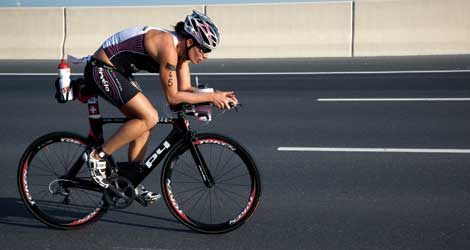Aero Water Bottle Placement
Triathletes have lots of options when it comes to figuring out where they want to put their water bottles.

Triathletes have lots of options when it comes to figuring out where they want to put their water bottles. You’ve got on the bike frame bottle cage placement, handlebar placement and, of course, one of the most popular choices, what we commonly refer to as rear hydration, where the water bottle cages sit behind the saddle.
People constantly ask me what the most aerodymanic rear hydration position is. I have spent a small fortune at the Low Speed Wind Tunnel here in San Diego. I have interviewed scores of people. I have observed hundreds, possibly thousands, of athletes in training and at races. I have the data, I have the knowledge, I have a personal opinion, but it really comes down to this: if you can’t reach it easily and can’t get that precious liquid and calories down you throat, it means nothing.
There are two common positions for rear hydration. A high position, where the bottles are right behind the saddle and sit about half way up the saddle, or a lower position that places the bottle behind the riders thighs. Typically, the higher positions tend to angle the bottles towards the rear. This makes it more difficult to grab the bottles, but looks like a sleek position. (The bottles look like missiles ready to launch.) The lower bottle position keeps the weight lower on the rear of the bike and makes it easier to lift your leg over the saddle to mount your bike. Both positions will work, the main difference comes down to personal preference.
What should go on your rear hydration carrier? Two cages for bottles and either your “fix-it” kit or a spare tubular. Most systems either offer a bag, or straps, to attach a bag or spare tubular. Some of the newer systems even have integrated Co2 holders so that you have a place to cleanly put those devices. I personally recommend always carrying two cartridges, since accidents happen!
Rocket Launchers
Rear hydration systems have developed a bad name, especially with cyclists, who will refer to the system as “rocket launchers.” Yes, even I have to admit that this name sometimes fits. It actually isn’t the unit that is the culprit, it is the bottle cages. Typically a bottle launches when either the cage is too loose and the bottle rattles around inside it, eventually falling out. Another scenario is when the unit and cage combo are so stiff that the road vibration (or simply the force from hitting a bump) blows the bottle out of the cage.
You need to find a cage that will hold the bottle snugly but still let you easily grab the bottle and slide it back in. There are some cages out there that are ultra tight, but at some point you’re likely to either bend or break the unit. I’m a fan of old-school wire cages (titanium or stainless steel) where you can bend the cage to achieve the perfect fit. That said, there are plenty of brand name plastic and composite cages that hold quite well.
Aerodynamics
The angle and placement of the bottles is key to the aerodynamics. Just because a manufacturer says this is the best place to put your water bottles doesn’t mean you can always benefit from it. Certain body types lend themselves to certain bottle placement areas, as does where one sits on the seat. If you place the bottles up high behind the saddle and sit on the nose, you lose the aero benefit that you would have if your backside was placed against the bottles, making them practically invisible to wind.
What does help, though, is reaching back, instead of reaching down, to grab a bottle off your frame. Reaching down to grab a bottle causes the head to go down, possibly exposing the tail of your aero helmet to the wind. Your cadence also tends to slow down. You add more wind resistance putting the bottle back on the frame mounted cage – most people look to see where the bottle is going (not a bad thing mind you) which again slows the riders cadence and tilts the head down. Reaching behind you does not cause your body to shift or move in the same way. Your hand reaches back and, hopefully, you won’t look behind you. Your arm remains along the body, in the same direction of the flow of wind so you won’t generate the same resistance you do when you reach down to the frame. The difference isn’t much, but it is measurable in a wind tunnel.
Aero and Comfort
I have seen firsthand people who have gone to a wind tunnel and dialed in the ultimate aero position for themselves and their rear hydration, only to be unable to reach their bottles easily or find themselves sitting so far forward that they lose the aero benefits of the position they perfected in the wind tunnel. When you’re setting up your rear hydration system you need to combine both ease of access and aerodynamics.
Andrew Block is the owner of Beaker Concepts which has outfitted champions of all three major cycling tours and Ironman world champions.
